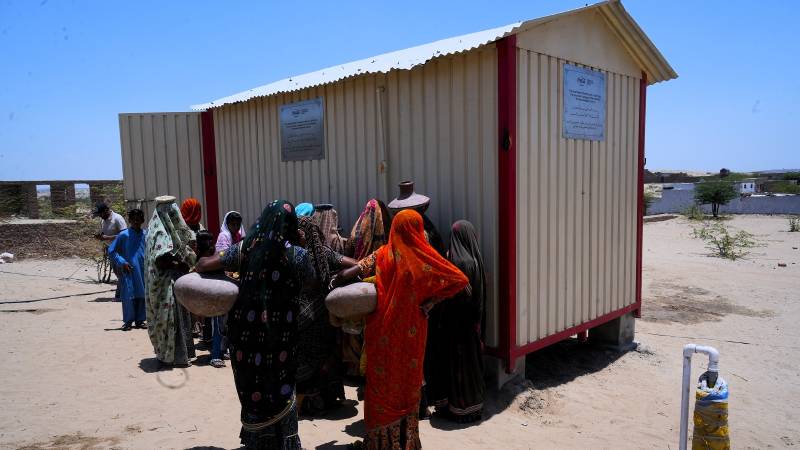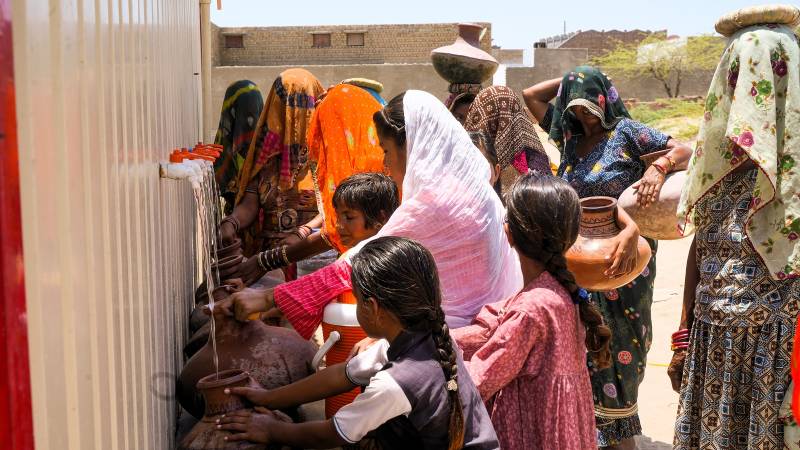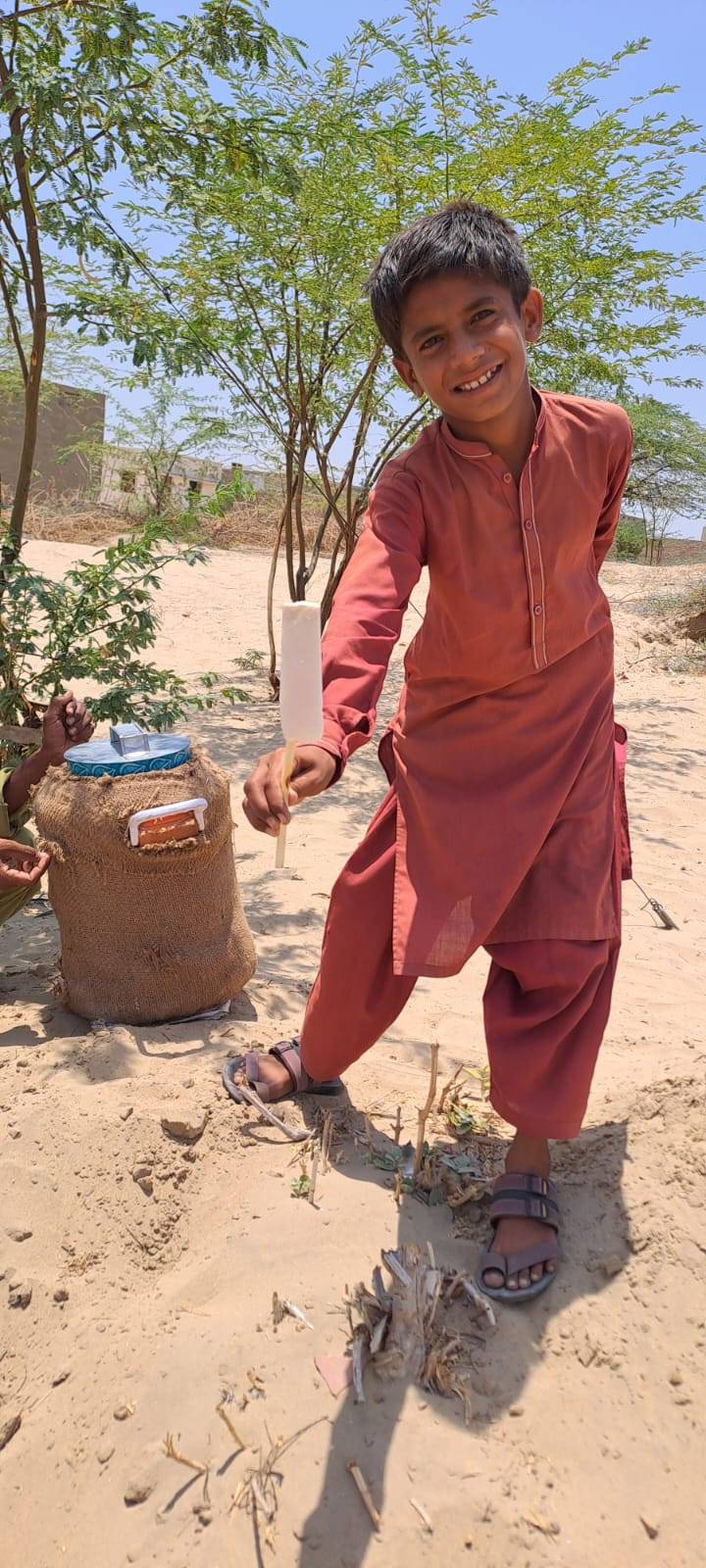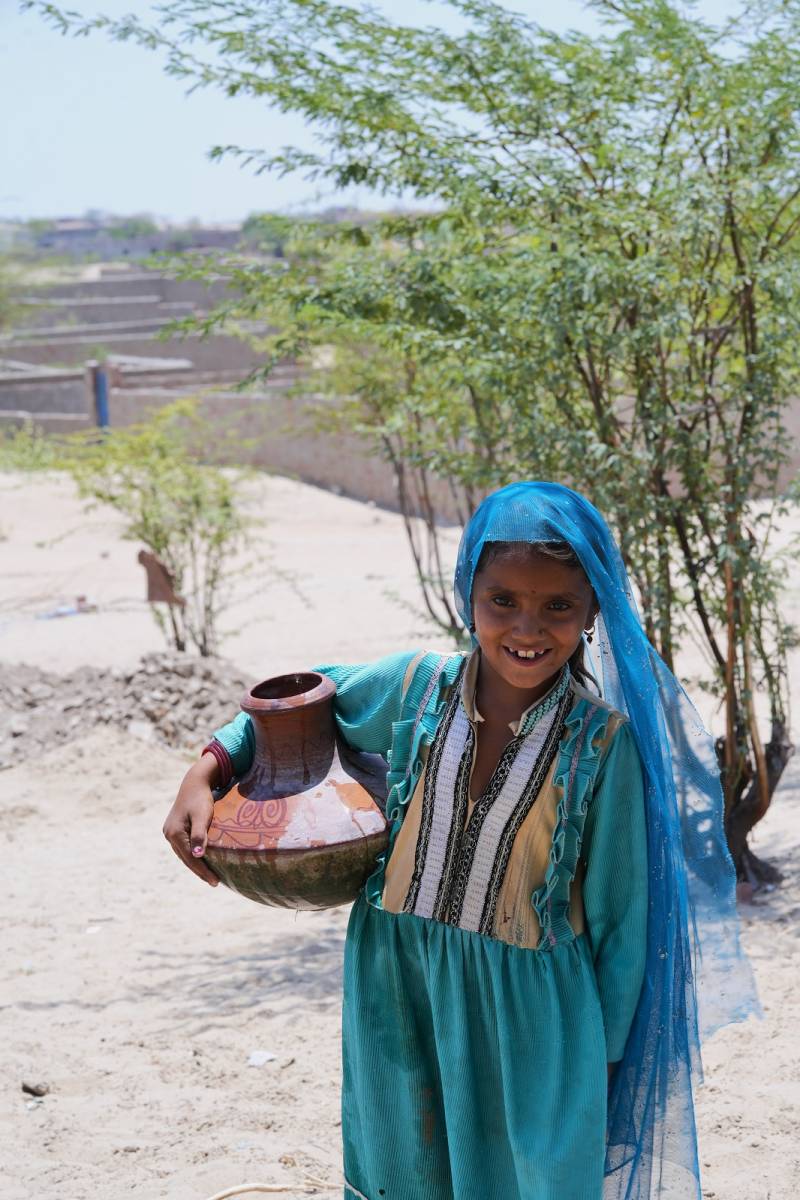
A chilled glass of water can feel like heaven on a hot day. As temperatures rise globally, Pakistan has become a bit of a hotspot, with temperatures soaring past 53° degrees recently, and the country is experiencing consecutive heat waves during the summer months. People naturally seek remedies - even temporary relief – from the heat like shade, covering their head under the scorching sun, restricting travel to cooler hours, wearing lighter clothes, using fans, air coolers, air-conditioners, and drinking plenty of water. Some people even sprinkle themselves and their surroundings with water to stave off the heat and help make the nightmarish temperatures a little bearable.
However, grabbing a bottle of cold water from the refrigerator and settling underneath a fan or an air-conditioner is a luxury many people simply do not have. Water is precious and is used precariously despite its demand. In certain parts of Pakistan, women have to walk between five and 50 kilometres—one way—to get water for their entire family; otherwise, their family and community suffer. There are no water tankers that can drive up and fill their tanks; if they want water, they must get it themselves in the scorching heat.
Until recently, the women of Megwarh, a Village near Umerkot in the arid region of Thar in Sindh, would get up early in the morning. Balancing pots on their heads or slinging them under their arms, they would walk across dunes before the sand became too hot to get water for some 800 households. After acquiring the water, they would have to walk back under the punishing sun and over scalding hot sand.
Megwarh is located on the fringes of the desert, with golden yellow sand dotted with small, green patches boiling in the sun. The arid landscape tells a tale of hardship and thirst. The health situation in this village is also quite precarious, as people, especially women and children, fall ill and even die due to dehydration and gastroenteritis.
The residents of Megwarh mostly comprise Hindus, and sometimes, their women can face problems when procuring water, adding to their immense burden.
A recent intervention, however, has helped address the issue of access to water. The construction of a solar-powered water filtration plant in the village has made access to water significantly easy for the residents of Megwarh. The women no longer have to walk long distances to fetch water; now, they can access clean drinking water right in the middle of their village, saving them from the gruesome task of walking long distances in severe heat and cold and thus saving them time, energy, and even lives.
The filtration plant has a maximum capacity to disburse some 1,000 litres (about 264 gallons) of water per hour, which is more than sufficient to meet the village's needs. The village now shares its surplus water with others from nearby villages.

How did a song change this?
The village of Megwarh gained prominence earlier this year when two residents were featured in Coke Studio Season 15.
Marvi and Saiban, from the village, were featured prominently in the marquee presentation of the latest season, singing the widely popular song "Aayi Aayi" alongside Noman Ali Rajper and rapper Babar Mangi.
The two folk singers had no idea how big the song would become, given that it was almost completely in Sindhi. But as soon as the song and its video depicting the cultural traditions of Sindh was released, it became popular. The song not only introduced the great voices of Marvi and Saiban to the mainstream music scene of Pakistan but also helped highlight before the nation the serious issue of water that the women of Megwarh have been facing for centuries.
As the song went viral, Marvi and Saiban became local celebrities; everyone wanted to be photographed with them.
"I had no idea that our song would bring water to our regions," a beaming Marvi said, "It is almost a miracle. We have songs for everything; music is part of our culture, but I didn't know our song could help to provide water to the people."
Clad in colourful shalwar suits and traditional jewellery, Marvi and Saiban smiled widely as local women and children approached them and requested selfies.
"It is so overwhelming," said Saiban in a low voice. Although shy, her wide smile revealed that she was thrilled with her newfound fame.
It was amazing how an artistic collaboration had led to a community service that would change the way the people, especially women, of Megwarh lived. It is fascinating that both, Marvi-probably named after the legendary Marvi who lived in the area centuries ago and about whom she sang in the song-and Saiban-which means shelter-were the ones who brought such resources to provide relief, water, and sustenance to their arid home.
While speaking with Marvi and Saiban, Pushpa beckoned from underneath her ghungut (long veil). She wanted to tell her story. She had lived in Megwarh all her life and seemed thrilled that a freshwater source was now available much closer to them.
"Do you know how tough it is to get water apart from all our other chores?" she asked. "Many women and their children fall ill during the hot weather, and some, especially younger children, can die of diarrhoea, and doctors say it is because of dirty water."
"Our lives will [now] become easier."
She said that sometimes they would be turned away when they went to fetch water because of their religion, but she vows no one will be turned away from getting water from the plant installed in their village.
Pushpa added that she could save time and finish her chores faster by having clean water only a few feet from her home. She laughed and added, "We can all sing."
She then joined Marvi and Saiban singing 'Aayi Aayi.'
The small crowd surrounding the plant seemed intrigued. The children were mesmerised as glass after glass of clear water was filled and passed around, unaware that their kulfis (cool ice and milk popsicles) were melting in the heat.

A young man selling some cool drinks near the water plant had many questions. "They are saying this works with the sun. Will it give water at night? How much water will we get?"
Some explained the plant's workings, and the vendor was fascinated to learn about the solar-powered plant and how it uses an ultrafiltration system to clean the water. The plant has been equipped with solar panels, GPS systems, and flowmeters to track performance and water dispensation. He seemed unfazed when told that the plant would be regulated and run by the area's women, noting the connection between women and the water supply to his community: "Yes, women bring water for their communities!"
Women, young and old, seemed more excited, probably because their lives would become easier. Rajna, who appeared to be barely more than 15 years of age, said, "My sister-in-law, sister, and I used to be so tired after walking for hours to get water, especially in the heat. And I used to be scared as well when there were so many strangers around."
Rajna had a petite frame, her arms lean, and her feet so small that it was difficult to picture the strength she possessed to lug heavy pitchers on her head for miles and miles.
"I am so happy that someone thought about us," she said as her earrings gleamed through her dupatta, which kept slipping off her head and which she hastily propped back on her head.
"Did Marvi and Saiban really become famous, and because of that, this source of clean drinking water was built near our villages?" She beamed at the two women who seemed to be the reason Rajna and her sisters would no longer have to walk long distances to procure water.
The tale of Umer-Marvi
It is almost as if Saiban's and Marvi's voices beckoned all those who heard their song to the desert, mesmerising them with their beautiful voices to help their cause of providing the parched population with easily accessible potable water.
The mesmerising song that Marvi and Saiban sang was a folk song about the iconic Marvi of Umerkot. Centuries ago, Umerkot, originally Amarkot, was famous for the Umer-Marvi saga. Folklore tells us that Marvi was a beautiful woman, and Umer was the ruler of the eponymous district. He fell in love with Marvi and pursued her. However, Marvi rejected Umer as she was already in love with someone else. This enraged Umer, who abducted her and then imprisoned her in his fort.
"This fort is of great historical significance. It was the prison where the beautiful Marvi was held captive by Umer, the ruler of Thar, many centuries ago," said Emmanuel Guddu - a local vlogger and historian of Sindh.
Despite Umer's advances and coercion, Marvi maintained her loyalty to her love. Despite her captivity, Marvi defied Umer, and after many years of imprisonment, he was compelled to release her. Upon her return home, her village rejoiced as she had remained loyal while she stood up to the ruler and won.
Guddu, who helped bring the song to life, shared his trove of wonderful stories and pictures from the region to provide an interesting perspective of Umerkot (Amarkot) Thar, like many storytellers of this beautiful place on the edge of the desert.
Elaborating on the history of the fort and local legends, Guddu said the area's social fabric has not changed much since the time of Umer and Marvi.

"Umerkot's original name is Amarkot, and it was named after Amar Singh, the ruler of Amarkot. According to some sources, Amar Singh built the fort. On the other hand, Umer was Umer Soomro, a king in Sindh's Sumra dynasty, which is believed to have reigned between 1050 and 1300."
He added that tourists who come to Umerkot visit the fort, impressed by its imposing structure and drawn by the legend of Umer-Marvi.
The town of Umerkot is located opposite the impressive fort. Across the road from the fort is a humble landscape of shops, workshops, and homes—a welcome respite from the country's bustling and polluted metropolises. Despite the modernisation of the region with metalled roads, overhead electricity, and communication cables, the general layout of the fort and residents scattered around it probably has not changed for centuries.
Building connections
Aisha F Sarwari, the senior director of public affairs at Coca-Cola Pakistan, visited Umerkot and the Megwarh village after the song went viral to build a deeper connection with residents of the area. Aisha and her team also planted tree saplings around the water pump installed in Megwarh to provide shade to the women who visit the pump to collect water and add to the area's ecosystem.
"By coming to Marvi's village, we are commemorating her love for her land and her people. But it is not easy to have a folklore without water," she said.
Aisha added: "Pakistani women struggle with access to clean drinking water nationwide, especially in arid areas. Their children often fall sick due to gastrointestinal diseases. This here is us adding a very tiny drop to sustainably solving an ocean of an issue."
The Megwarh water plant is part of Coca-Cola's 'Water For Women Program,' which believes that when women thrive, communities prosper. So far, its umbrella, the Paani Project, has served about 17 million people across 53 plants across the nation.
Music with a cause is a workable way of using art to shine a light on areas and issues creating hardships for people and thus helping improve the lives of millions. The cash and resources-strapped government can collaborate with the private sector to work on sectors that have been ignored or sidelined for other projects. Such collaborations will help reach more people across Pakistan, especially in remote areas. Only with public and private collaboration will Pakistan be able to tackle the myriad of problems faster, which only increases with time and neglect.

